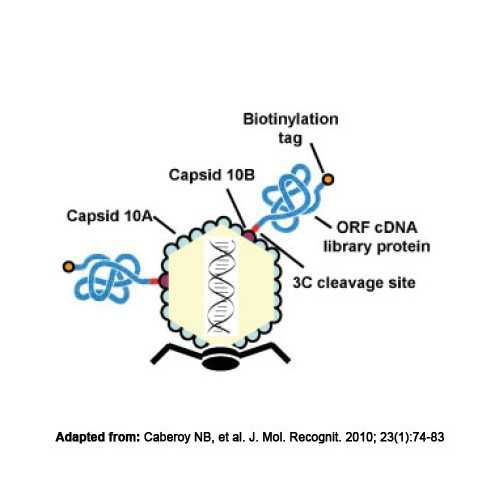E. coli Strain BLT7Bio
E. coli strain with expressing capsid 10A with a C-terminal biotinylation tag for phage display studies.
Highlights:
- Allows for dual phage display utilizing E. coli Strain BLT7FLAG
- Broadly applicable to bait proteins or non-protein molecules
- Capable of identifying unknown bait-binding proteins in as fast as 4–7 days
Bacteriophage T7 is a bacteriophage capable of infecting susceptible bacterial cell (mostly E. coli). Bacteriophage T7 is a DNA virus that has a lytic life cycle. The T7 bacteriophage has several properties that make it an ideal phage for experimentation.
From the laboratory of Wei Li, PhD, University of Miami.
E. coli strain with expressing capsid 10A with a C-terminal biotinylation tag for phage display studies.
Highlights:
- Allows for dual phage display utilizing E. coli Strain BLT7FLAG
- Broadly applicable to bait proteins or non-protein molecules
- Capable of identifying unknown bait-binding proteins in as fast as 4–7 days
Bacteriophage T7 is a bacteriophage capable of infecting susceptible bacterial cell (mostly E. coli). Bacteriophage T7 is a DNA virus that has a lytic life cycle. The T7 bacteriophage has several properties that make it an ideal phage for experimentation.
From the laboratory of Wei Li, PhD, University of Miami.
| Product Type: | Bacteria |
| Name: | BLT7Bio |
| Cell Type: | E. coli |
| Organism: | Bacteria |
| Genotype: | F? , ompT, hsdSB (rB ? , mB ? ), dcm, gal, 10A-Biotin |
| Antibiotic Resistance: | Carbenicillin |
| Competency: | No |
| Growth Conditions: | Lysogeny broth (LB) or Terrific broth (TB) medium |
| Transformation: | Culture BLT7Bio bacteria until the OD600 reaches to 0.5; add IPTG (1 mM) to bacteria and continue shaking for 30 min. BLT7Bio can be stored at 4C for up to 2 days; add T7 phage at appropriate titer to the bacteria and shake at 37C until lysis. |
| Induction: | IPTG for 30 min at 37C with shaking |
| Storage: | Uninduced BLT7Bio should be stored at -80C for long-term storage; IPTG-induced BLT7Bio should be stored at 4C for 2 days. |
| Shipped: | Dry ice |
Notes:
T7 phage amplified in BLT7Bio bacteria will have all surface capsid 10A (~400 copies/phage) displaying biotin. This will not affect foreign proteins displayed on C-terminus of capsid 10B.Use horseradish peroxidase-conjugated streptavidin to detect bound phage amplified in BLT7Bio bacteria.
- Caberoy NB, Zhou Y, Jiang X, Alvarado G, Li W. Efficient identification of tubby-binding proteins by an improved system of T7 phage display. J. Mol. Recognit. 2010; 23(1):74-83
If you publish research with this product, please let us know so we can cite your paper.


